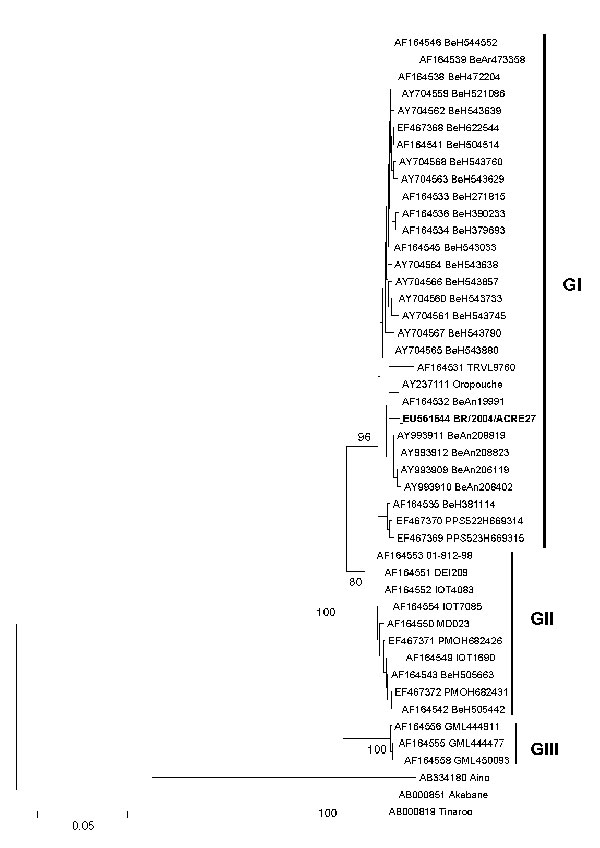Volume 15, Number 2—February 2009
Letter
Sporadic Oropouche Infection, Acre, Brazil
Figure

Figure. Phylogenetic tree of Oropouche virus strains; boldface shows the sample from the patient in this study. Phylogenetic tree was constructed from partial nucleocapsid gene sequence (522 nt, 27–200 aa) by neighbor-joining method implemented in MEGA 3.0 software (9). Kimura 2-parameter nucleotide substitution model was used, and the reliability of the branching patterns was tested by 1,000 bootstrap pseudo replicates. Bootstrap values (%) are shown in main nodes. Aino, Akabane, and Tinaroo viruses were used as the out group. The scale bar represents 5% nucleotide sequence divergence. GenBank accession numbers are provided and are grouped by strain designation. GI, genotype I; GII, genotype II; GIII, genotype III.
References
- Pinheiro FP, Travassos da Rosa APA, Vasconcelos PFC. Oropouche fever. In: Feigin RD, editor. Textbook of pediatric infectious diseases. Philadelphia: WB Saunders Co.; 2004. p. 2418–23.
- Anderson CR, Spence L, Downs WG, Aitken THG. Oropouche virus: a new human disease agent from Trinidad, West Indies. Am J Trop Med Hyg. 1961;10:574–8.PubMedGoogle Scholar
- Saeed MF, Wang H, Nunes M, Vasconcelos PF, Weaver SC, Shope RE, Nucleotide sequences and phylogeny of the nucleocapsid gene of Oropouche virus. J Gen Virol. 2000;81:743–8.PubMedGoogle Scholar
- Nunes MR, Martins LC, Rodrigues SG, Chiang JO, Azevedo RSS, da Rosa AP, Oropouche virus isolation, southeast Brazil. Emerg Infect Dis. 2005;11:1610–3.PubMedGoogle Scholar
- Azevedo RSS, Nunes MRT, Chiang JO, Bensabath G, Vasconcelos HB, Pinto AYN, Reemergence of Oropouche fever, northern Brazil. Emerg Infect Dis. 2007;13:912–5.PubMedGoogle Scholar
- Silva-Nunes M, Malafronte RS, Luz BA, Souza EA, Martins LC, Rodrigues SG, The Acre Project: the epidemiology of malaria and arthropod-borne virus infections in a rural Amazonian population. Cad Saude Publica. 2006;22:1325–34. DOIPubMedGoogle Scholar
- de Morais Bronzoni RV, Baleotti FG, Nogueira RMR, Nunes M, Figueiredo LTM. Duplex reverse transcription-PCR followed by nested PCR assays for detection and identification of Brazilian alphaviruses and flaviviruses. J Clin Microbiol. 2005;43:696–702. DOIPubMedGoogle Scholar
- Moreli ML, Aquino VH, Cruz AC, Figueiredo LT. Diagnosis of Oropouche virus infection by RT-nested-PCR. J Med Virol. 2002;66:139–42. DOIPubMedGoogle Scholar
- Kumar S, Tamura K, Nei M. MEGA3: Integrated software for molecular evolutionary genetics analysis and sequence alignment. Brief Bioinform. 2004;5:150–63. DOIPubMedGoogle Scholar
- Shope RE. The use of a micro-hemagglutination test to follow antibody response after arthropod-borne virus infection in a community of forest animals. [Rio J]. Ann Microbiol. 1963;11:167–71.
Page created: December 08, 2010
Page updated: December 08, 2010
Page reviewed: December 08, 2010
The conclusions, findings, and opinions expressed by authors contributing to this journal do not necessarily reflect the official position of the U.S. Department of Health and Human Services, the Public Health Service, the Centers for Disease Control and Prevention, or the authors' affiliated institutions. Use of trade names is for identification only and does not imply endorsement by any of the groups named above.